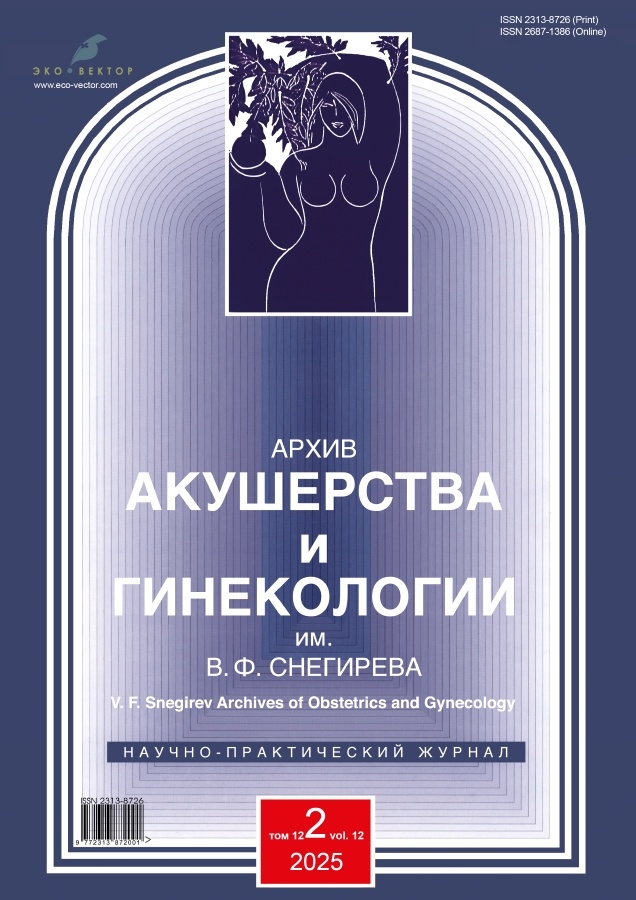不使用网状植入物矫正压力性尿失禁和盆底器官脱垂的现代治疗策略评估
- 作者: Dobrohotova Y.E.1, Lapina I.A.1, Glebov Н.V.2, Kaykova O.V.2, Chirvon T.G.1, Tyan A.G.2, Taranov V.V.1
-
隶属关系:
- Pirogov Russian National Research Medical University
- MEDSI Group of Companies
- 期: 卷 12, 编号 2 (2025)
- 页面: 235-245
- 栏目: Original study articles
- ##submission.dateSubmitted##: 23.01.2025
- ##submission.dateAccepted##: 07.04.2025
- ##submission.datePublished##: 10.06.2025
- URL: https://archivog.com/2313-8726/article/view/646578
- DOI: https://doi.org/10.17816/aog646578
- EDN: https://elibrary.ru/FPARIH
- ID: 646578
如何引用文章
详细
论证。约有40%至80%的50岁以上女性患有不同程度的盆底器官脱垂,其中常伴有压力性尿失禁。随着盆底外科手术中逐步放弃异物性网状植入物,寻找替代治疗手段成为一项重要课题。
目的。评估在不使用网状植入物的前提下矫正压力性尿失禁和盆底器官脱垂的可能性。
材料与方法。本项前瞻性临床研究纳入70例不同程度盆底器官脱垂的女性。根据POP-Q分期,只有在合并压力性尿失禁主诉的情况下,I期盆底器官脱垂患者才被纳入本研究。该部分患者被单独划为第1组(n=24)。根据POP-Q分期,第2组纳入了Ⅱ–Ⅳ期盆底器官脱垂,且必须伴有阴道顶端区脱垂的患者(n=46)。两组患者均进一步分为若干亚组。1A亚组患者行经尿道体积填充剂注射,1B亚组患者行传统TVT-O悬吊术。第2组根据所属亚组接受两种不同的手术方式:2A亚组接受基于自体组织和缝合材料的无网片腹腔镜宫颈残端骶骨固定术(mesh-less),2B亚组接受使用聚丙烯网状植入物的传统腹腔镜骶阴道固定术。
结果。第1组中,注射填充剂治疗12个月后的临床疗效维持率为40%,不到采用网片吊带术组(93%)的一半。在严格选择患者的前提下,体积填充剂有望使部分盆底器官脱垂I期合并压力性尿失禁患者转为门诊治疗,从而减少住院压力并降低异物植入率。第2组术后1个月的解剖学成功率为:2A亚组(mesh-less)为92%,2B亚组为90%(p=0.265)。尽管一年随访期间各亚组的复发率相近,但要全面评估治疗成功率,仍需对患者进行5–10年的长期随访。
结论。尽管各种网状植入物在盆底手术中仅具有有限优势,但其高昂的成本以及术中和术后并发症的增多,促使治疗趋势转向使用自体组织的改良手术方法和治疗压力性尿失禁的非手术注射技术。
全文:
作者简介
Yulia E. Dobrohotova
Pirogov Russian National Research Medical University
Email: pr.dobrohotova@mail.ru
ORCID iD: 0000-0002-7830-2290
SPIN 代码: 2925-9948
MD, Dr. Sci. (Medicine), Professor
俄罗斯联邦, MoscowIrina A. Lapina
Pirogov Russian National Research Medical University
Email: doclapina@mail.ru
ORCID iD: 0000-0002-2875-6307
SPIN 代码: 1713-6127
MD, Dr. Sci. (Medicine)
俄罗斯联邦, MoscowНикита V. Glebov
MEDSI Group of Companies
Email: glebov.nikita2@mail.ru
ORCID iD: 0000-0002-7072-6953
俄罗斯联邦, Moscow
Olesya V. Kaykova
MEDSI Group of Companies
Email: kajkova.ov@medsigroup.ru
ORCID iD: 0000-0003-2338-1128
俄罗斯联邦, Moscow
Tatiana G. Chirvon
Pirogov Russian National Research Medical University
编辑信件的主要联系方式.
Email: tkoltinova@gmail.com
ORCID iD: 0000-0002-8302-7510
MD, Cand. Sci. (Medicine)
俄罗斯联邦, MoscowAnatoliy G. Tyan
MEDSI Group of Companies
Email: doctortyan@yandex.ru
ORCID iD: 0000-0003-1659-4256
SPIN 代码: 6960-9405
MD, Cand. Sci. (Medicine)
俄罗斯联邦, MoscowVladislav V. Taranov
Pirogov Russian National Research Medical University
Email: vlastaranov@mail.ru
ORCID iD: 0000-0003-2338-2884
SPIN 代码: 6974-0237
MD, Cand. Sci. (Medicine)
俄罗斯联邦, Moscow参考
- Popov AA, Krasnopolskaya IV, Fedorov AA, et al. Modern mesh implants in genital prolapse surgery. Obstetrics and Gynecology of St. Petersburg. 2018;(3-4):57–58. (In Russ.) EDN: YVCBCN
- Shakhaliev RA, Shulgin AS, Kubin ND, et al. Current status of transvaginal mesh implants use in the surgical treatment of stress urinary incontinence and pelvic prolapse. Gynecology. 2022;24(3):174–180. doi: 10.26442/20795696.2022.3.201423 EDN: ZEDFCS
- Management of mesh and graft complications in gynecologic surgery. Committee Opinion No. 694. American College of Obstetricians and Gynecologists. Obstet Gynecol. 2017;129(4):e102–e108. doi: 10.1097/AOG.0000000000002022
- Wang B, Chen Y, Zhu X, et al. Global burden and trends of pelvic organ prolapse associated with aging women: an observational trend study from 1990 to 2019. Front Public Health. 2022;10:975829. doi: 10.3389/fpubh.2022.975829
- Drutz HP, Alarab M. Pelvic organ prolapse: demographics and future growth prospects. Int Urogynecol J Pelvic Floor Dysfunct. 2006;17 (Suppl 1):S6–S9. doi: 10.1007/s00192-006-0102-1
- Wallace SL, Syan R, Sokol ER. Surgery for apical vaginal prolapse after hysterectomy: transvaginal mesh-based repair. Urol Clin North Am. 2019;46(1):103–111. doi: 10.1016/j.ucl.2018.08.005
- Clinical guidelines: Urinary incontinence. 2024–2025–2026 (07.08.2024). Approved by the Russian Ministry of Health. (In Russ.) URL: http://disuria.ru/_ld/14/1449_kr24N39R32MZ.pdf
- Nutaitis AC, George EL, Mangira CJ, et al. Trends in urogynecologic surgery among obstetrics and gynecology residents from 2002 to 2022. Urogynecology (Phila). 2024;30(1):73–79. doi: 10.1097/SPV.0000000000001385
补充文件











